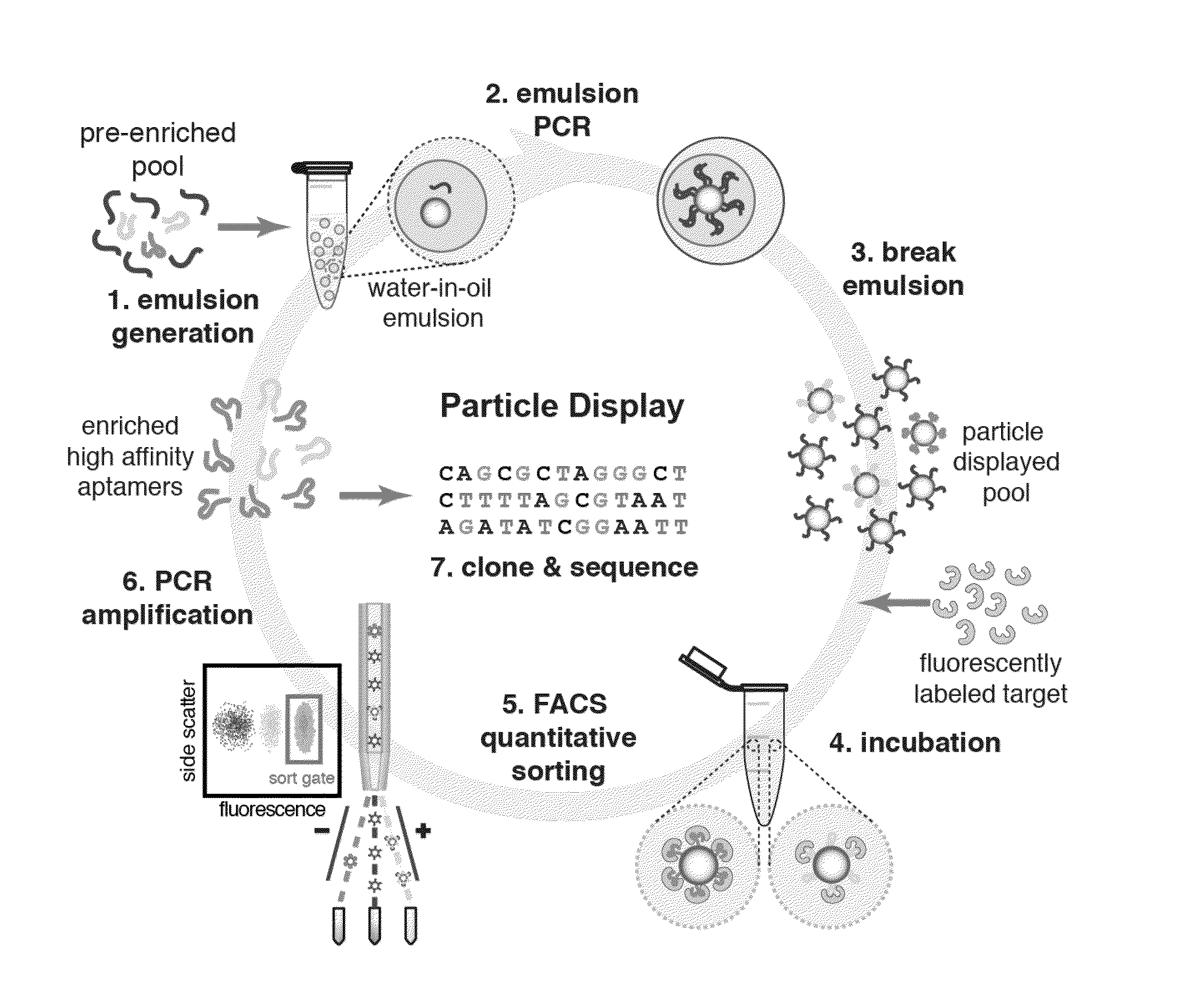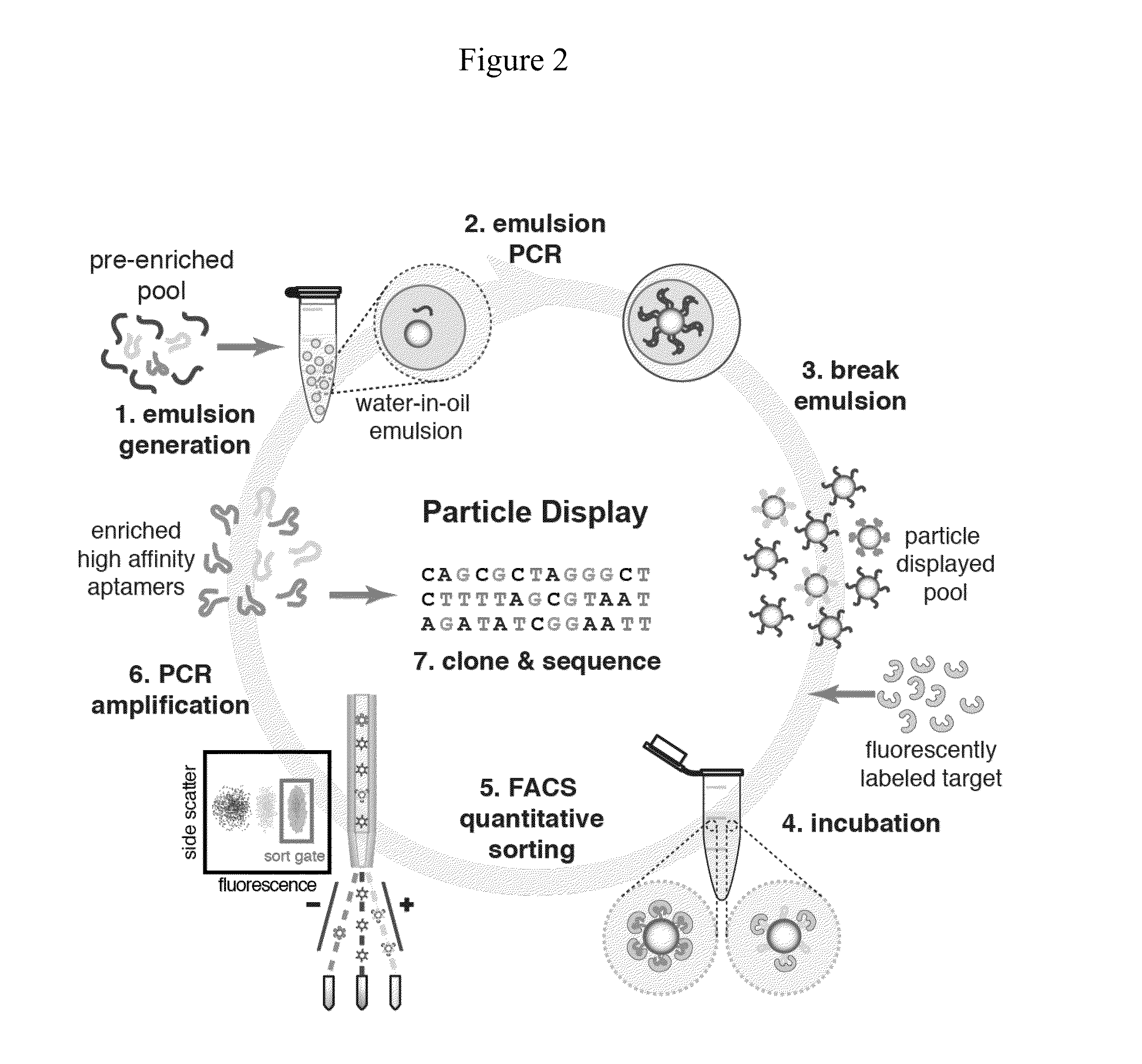Screening of nucleic acid agents via particle display
a nucleic acid agent and particle technology, applied in the direction of nucleotide libraries, library screening, directed macromolecular evolution, etc., can solve the problems of limited chemical interaction repertoire, inability to yield aptamers with comparable affinity and specificity relative to antibodies, and difficult to discard aptamer sequences that proliferate, etc., to eliminate the confounding
- Summary
- Abstract
- Description
- Claims
- Application Information
AI Technical Summary
Benefits of technology
Problems solved by technology
Method used
Image
Examples
example 1
Aptamer Particle (Ap) Synthesis
1. Methods and Materials
[0316]Coupling Forward Primers (FP) to Particles:
[0317]As a first step in the preparation of APs, forward primers (FP) were coupled to magnetic particles using the following methods.
[0318]500 μL of 1-μm MyOne carboxylic acid magnetic particles (107 / μL, Life Technologies) were washed once with 500 μL of 0.01N NaOH, and then three times with 1 mL of nuclease-free water. After the last wash, the particles were resuspended in a 150 μL reaction mixture containing 200 mM NaCl, 0.2 mM 5′-amino-modified FP (5′-amino-PEG18-AGC AGC ACA GAG GTC AGA TG-3′) (SEQ ID NO:81), 1 mM imidazole chloride, 50% v / v dimethyl sulfoxide (DMSO) and 250 mM 1-ethyl-3-(3-dimethylaminopropyl)carbodiimide (EDC). Amino group modification was chosen because this coupling is covalent and can keep FPs attached to the particles during thermal cycling, with the PEG18 at the 5′ end of FP serving as a spacer. Particles were mixed well with reagents, vortexed, sonicate...
example 2
Optimization of Aptamer Particle (Ap) Synthesis
1. Methods and Materials
[0327]As discussed above, APs may be formed by performing PCR on the surfaces of magnetic beads within water-in-oil emulsions where each droplet ideally contains a single FP-coated magnetic particle and a single template DNA molecule. (FIG. 2, panel (a), step 1, FIG. 4, panel (a)). The efficiency of the process for generating ssDNA-conjugated particles was first tested. It was determined that 5′ amino-modified FP can be covalently conjugated to 1-μm-diameter carboxylic acid particles and remain stable during PCR thermal cycling. After the particles were coupled with FP, particle PCR was performed using the FP-coated particles to display an individual test sequence on the particles. The reverse strands were removed by adding NaOH after completing 30 cycles of PCR. To test the FP conjugation and particle PCR efficiency, aliquots of these particles were annealed with Alexa Fluor 488-labeled FPC or RP and their fluor...
example 3
De Novo Particle Display Aptamer Screen Against Four Protein Targets
1. Methods and Materials
[0330]Biotinylation of Protein Targets:
[0331]Exemplary protein targets for use in validating the theoretical advantages of the systems and methods disclosed herein were prepared as follows. The following (His)6 tag-labeled protein targets were purchased: human alpha-thrombin (Haematologic Technologies, Inc., Catalog #: HCT-0020), recombinant human Apolipoprotein E3 (ApoE3) (R&D Systems, Accession #:P02649), Recombinant Human 4-1BB / TNFRSF9 / CD137 Fc Chimera (R&D Systems, Accession #:Q07011) and Human Plasminogen activator inhibitor-1 (PAI-1) (Millipore, UniProt Number: P05121). All four proteins were biotinylated using the EZ-Link Micro NHS-PEO4-Biotinylation Kit (Pierce Biotechnology), which includes a polyethylene glycol (PEG) spacer to improve the water solubility of the biotinylated protein. The concentrations of all four proteins were adjusted to 0.5 mg / mL using phosphate-buffered saline (...
PUM
| Property | Measurement | Unit |
|---|---|---|
| diameter | aaaaa | aaaaa |
| diameter | aaaaa | aaaaa |
| molecular weight | aaaaa | aaaaa |
Abstract
Description
Claims
Application Information
 Login to View More
Login to View More - R&D
- Intellectual Property
- Life Sciences
- Materials
- Tech Scout
- Unparalleled Data Quality
- Higher Quality Content
- 60% Fewer Hallucinations
Browse by: Latest US Patents, China's latest patents, Technical Efficacy Thesaurus, Application Domain, Technology Topic, Popular Technical Reports.
© 2025 PatSnap. All rights reserved.Legal|Privacy policy|Modern Slavery Act Transparency Statement|Sitemap|About US| Contact US: help@patsnap.com



